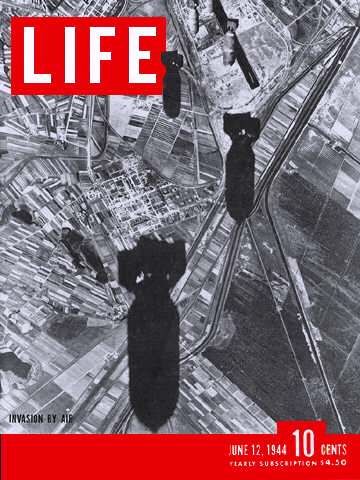
AT "ABERDEEN," AN AIR BASE IN THE BURMESE JUNGLE, COLONEL PHILIP COCHRAN (LEFT) DISCUSSES EVACUATION OF WOUNDED RAIDERSWITH BRITISH OFFICERS

The unbelievable mistake of an English teletype operator shocked the U.S. with false news of invasion. The radio announcers, breaking in on the horse-race descriptions and the dramatic programs, caused millions of Americansto tremble with long-expected excitement. In baseball parks, games were halted and spectators offered silent prayers.
The retraction was a letdown. But the incident had thickened the oppressive atmosphere of expectancy. And the real warcontinued. Allied troops captured Rome. In the Pacific, U.S. troops fought on Biak Island, only 900 miles from thePhilippines. Biak seemed only a preliminary to climatic new blows from the enormous U.S. naval power. Slow alliedsuccesses advanced the western arm of the gigantic pincers against Japan. From Burma came the photographic recordon this page of an important fragment of this war's history - the fight by Lieut. General Joseph Stilwell's men toreopen the land route to China.
Stilwell's immediate objective was to drive the Japs out of Myitkyina, main barrier on the way to China. A good partof his success there has been due to a mixed force of Englishmen, Americans, West Africans and Gurkhas which has never been within sight of the city. Three months ago a U.S. air force, commanded by Colonel Philip G. Cochran, landeda small army of raiders in the jungle behind the Japanese. There they have harassed Japanese communications, wonvictories, suffered defeats and inevitably upset Japanese plans. Their tactics paid off last month when Stilwell's mentook the Myitkyina airfield from the weakened Japanese. Colonel Cochran, who arrived in the U.S. last week, has become nearly as famous as Flip Corkin, the character in Milton Caniff's Terry and the Pirates whom he inspired.
Although the aerial tactics used by Colonel Cochran's planes were revolutionary, the ground fighting which engaged the raiders followed an ancient pattern. These photographs by LIFE's William Vandivert are strongly reminiscent of the grim and real pictures the great Mathew Brady took 80 years ago on the battlefield of America's War Between theStates.

Haggard British Casualties rest by side of improvised air strip as they wait to be evacuated by light planes.These men are part of a raiding force which left main road block southwest of Myitkyina to hit Japanese farthersouth. Two native troopers stand with fixed bayonets at left, guarding captured Burmese collaborators, Japanesesoldier who will also be flown out.

Quiet, sweating wounded lie in tent at main air base of airborne troops behind Japanese lines. They have been flown in from foreword positions by light planes, will be flown back to India by big transports at night.At this base the wounded get their first good medical care. Most of these men were wounded at road block by Japaneseshelling and bombing the night before.

Dull-eyed raiders bring litter case out of teak jungle on narrow trail. Man standing at left is one of WestAfricans who fought with raiding party. He watches jungle in case Japanese try to filter through and take littleair strip immediately behind the camera. The man walking at the left of the column carries two British Lee Enfieldrifles, his own and the wounded man's.

"White City" road block, cutting road and rail line to Myitkyina, is supplied by light planes. Above are twoL-1s (Vultee Vigilants) which have landed on strip between rail embankment and road.
| U.S. LIGHT-PLANE PILOTS SUPPLY TROOPS IN JUNGLE |
Like jungle tactics, jungle uniforms are varied and unconventional. The U.S. light-plane men pictured below are sporting a raffish assortment of British campaign hats, garrison caps, overseas caps, pith helmets and baseballcaps. In any kind of hat, these men do a good part of aerial trucking in Burma. Their handy little planes have becomecapillaries of jungle supply. The arteries are transports which fly heavy loads to big interior bases. From herethe light planes fly to the troops. Sometimes they drop their loads by parachute, but their greatest advantage is thatthey can land and take off in tiny areas where larger planes would crash.


 Ammunition is dropped by parachute to men of raiding columns waiting in rice paddy. Troops sometimes clear strips through paddy so that plane can land, take out wounded. Ammunition is dropped by parachute to men of raiding columns waiting in rice paddy. Troops sometimes clear strips through paddy so that plane can land, take out wounded. |
 Barbed-wire entanglement and dugouts on hill kept Japanese from getting through for 76 days. But after continuousattacks the Chindits were forced to abandon this block in the last week of May. Barbed-wire entanglement and dugouts on hill kept Japanese from getting through for 76 days. But after continuousattacks the Chindits were forced to abandon this block in the last week of May. |
| Time, LIFE, Fortune and the Architectural Forum have been cooperating with the War Production Board ever since Jan., 1943, on the conservation of paper. During the year 1944 these four publications of the Timegroup are budgeted to use 73,000,000 pounds (1,450 freight carloads) less paper than in 1942. In view of resultingshortages of copies, please share your copy of LIFE with your friends. ALL MATERIAL, WHICH IN THE OPINION OF THE EDITORS INVOLVES MILITARY SECURITY, HAS BEEN SUBMITTED TO COMPETENTMILITARY OR NAVAL AUTHORITY FOR REVIEW AS TO SECURITY. |

LIFE'S COVER: By end of May, D-Day for ground invasion was a definite date on the allied high command'scalendar. But invasion by air, which was just as real as one by foot soldier and artillery, had been a definitemilitary fact for months before. The particular bombs on the cover are 500-pounders, tumbling on an oil refinery in Leghorn, Italy.

Adapted by Carl W. Weidenburner
from the second June 12, 1944 issue of LIFE.
Portions copyright 1944 Time, Inc.
MORE ABOUT THIS ISSUE
WARTIME ADVERTISING IN LIFE
MORE CBI FROM LIFE MAGAZINE
TOP OF PAGE
FOR PRIVATE NON-CIMMERCIAL HISTORICAL REFERNCE ONLY